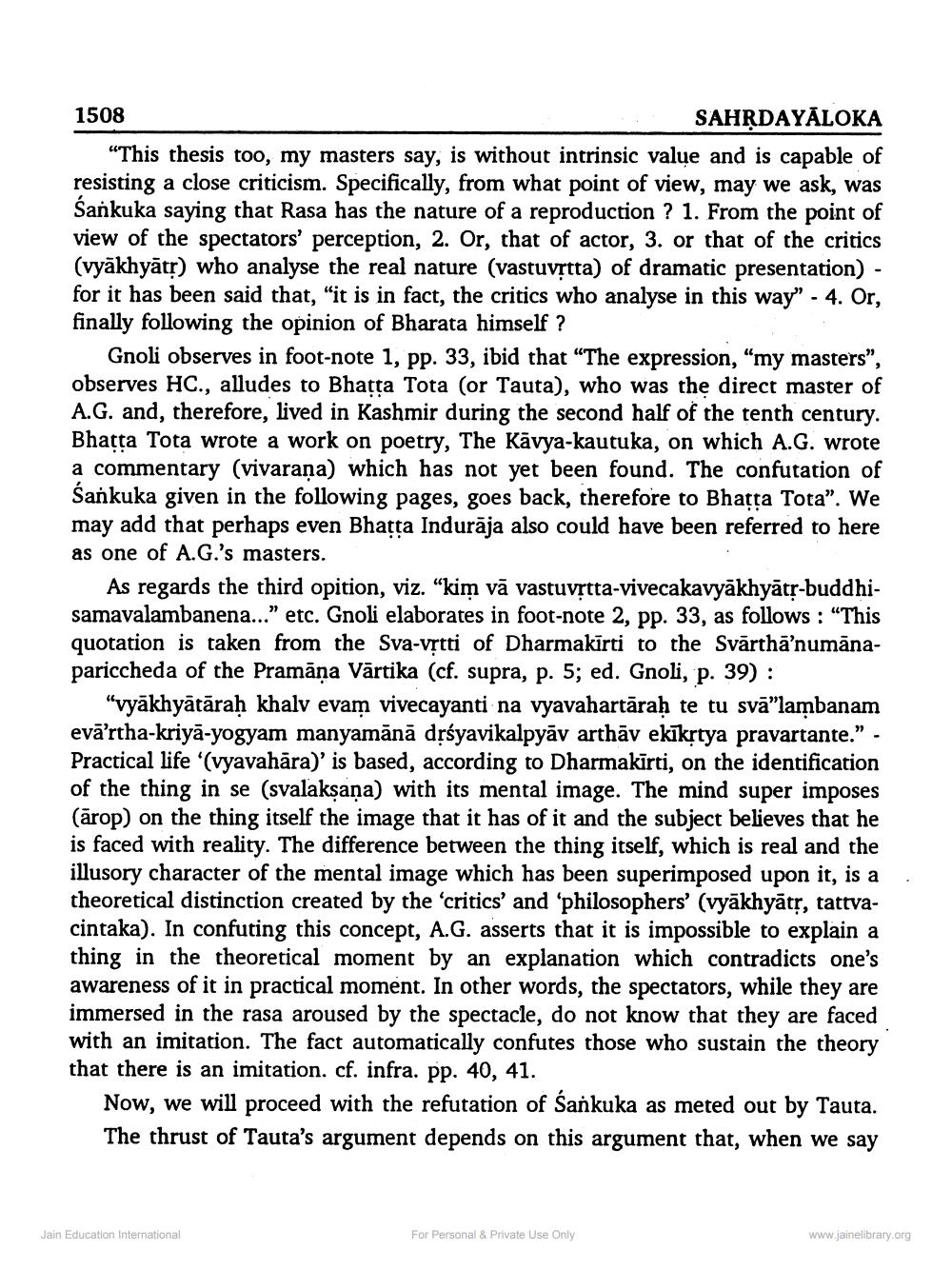________________
1508
SAHṚDAYALOKA
"This thesis too, my masters say, is without intrinsic value and is capable of resisting a close criticism. Specifically, from what point of view, may we ask, was Śankuka saying that Rasa has the nature of a reproduction? 1. From the point of view of the spectators' perception, 2. Or, that of actor, 3. or that of the critics (vyākhyātṛ) who analyse the real nature (vastuvṛtta) of dramatic presentation) - for it has been said that, "it is in fact, the critics who analyse in this way" - 4. Or, finally following the opinion of Bharata himself?
Gnoli observes in foot-note 1, pp. 33, ibid that "The expression, "my masters", observes HC., alludes to Bhaṭṭa Tota (or Tauta), who was the direct master of A.G. and, therefore, lived in Kashmir during the second half of the tenth century. Bhatta Tota wrote a work on poetry, The Kavya-kautuka, on which A.G. wrote a commentary (vivaraṇa) which has not yet been found. The confutation of Śankuka given in the following pages, goes back, therefore to Bhatta Tota". We may add that perhaps even Bhaṭṭa Indurāja also could have been referred to here as one of A.G.'s masters.
As regards the third opition, viz. "kim vā vastuvṛtta-vivecakavyākhyātṛ-buddhisamavalambanena..." etc. Gnoli elaborates in foot-note 2, pp. 33, as follows: "This quotation is taken from the Sva-vṛtti of Dharmakirti to the Svartha'numanapariccheda of the Pramāņa Vārtika (cf. supra, p. 5; ed. Gnoli, p. 39):
"vyākhyātāraḥ khalv evam vivecayanti na vyavahartāraḥ te tu svā"lambanam eva'rtha-kriya-yogyam manyamānā dṛśyavikalpyāv arthāv ekīkṛtya pravartante." Practical life '(vyavahāra)' is based, according to Dharmakirti, on the identification of the thing in se (svalakṣaṇa) with its mental image. The mind super imposes (ārop) on the thing itself the image that it has of it and the subject believes that he is faced with reality. The difference between the thing itself, which is real and the illusory character of the mental image which has been superimposed upon it, is a theoretical distinction created by the 'critics' and 'philosophers' (vyäkhyātṛ, tattvacintaka). In confuting this concept, A.G. asserts that it is impossible to explain a thing in the theoretical moment by an explanation which contradicts one's awareness of it in practical moment. In other words, the spectators, while they are immersed in the rasa aroused by the spectacle, do not know that they are faced with an imitation. The fact automatically confutes those who sustain the theory that there is an imitation. cf. infra. pp. 40, 41.
Now, we will proceed with the refutation of Śankuka as meted out by Tauta. The thrust of Tauta's argument depends on this argument that, when we say
Jain Education International
For Personal & Private Use Only
www.jainelibrary.org




